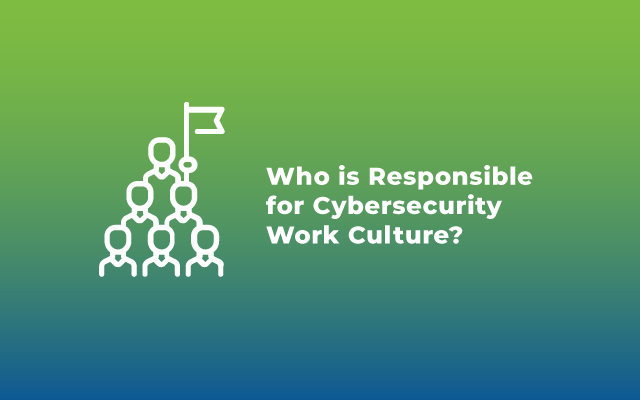
Who Is Responsible for Cybersecurity Work Culture?
As a cybersecurity and managed security services provider (MSSP), American Technology Services understands the importance of a robust and comprehensive cybersecurity strategy.
It is not solely the responsibility of the IT department or the Chief Information Security Officer (CISO) to ensure a secure network and up-to-date information security (infosec) policies. Instead, cybersecurity work culture is a shared responsibility that must be instilled in every employee at every level of the organization. This article will explore who is responsible for instilling a cybersecurity work culture and how ATS approaches cybersecurity through work culture.
Behavior, Knowledge, and Standards
IT consulting and IT support services can play a critical role in creating a strong culture of cybersecurity in the workplace. Understanding the importance of cybersecurity and the potential risks associated with a breach is essential for all employees.
Ongoing training and education are necessary to keep up with the constantly evolving cyber threats. Employees should know best practices such as using strong passwords, identifying phishing scams, and reporting suspicious activity. Clear security standards should also be established and communicated to all employees. Policies and procedures such as password management, data encryption, and access controls should be implemented to ensure compliance.
IT consulting and IT support services can help organizations establish and maintain these security standards and provide ongoing training and education to employees.
Shared Responsibility
Cybersecurity is not just the responsibility of the IT department or the CISO. It is a shared responsibility that involves all employees of the organization. Every employee has a role to play in ensuring a secure network. This includes practicing cybersecurity hygiene, reporting suspicious activity, and following established security protocols.
By creating a culture of cybersecurity, organizations can reduce the risk of breaches and protect their sensitive data.
Cross-Functional Boundaries
Creating a culture of cybersecurity requires breaking down silos and establishing cross-functional boundaries. Cybersecurity cannot be sold to the IT department alone. It must involve all departments, including HR, finance, marketing, and operations.
Each department has unique risks and vulnerabilities that must be addressed when considering policies and practices for cybersecurity hygiene. For example, the HR department may handle sensitive employee data, while the finance department may handle sensitive financial information. All departments must work together to identify and mitigate potential risks.
ATS’ Security-First Practices
At American Technology Services (ATS), information security is a top priority. As an award-winning managed security services provider headquartered in NYC and the metro DC area, ATS has established several security-first practices to ensure their organization’s and clients’ security.
Let’s look at how ATS approaches cybersecurity in various areas of the organization:
Human Resources Employee Training
ATS provides ongoing employee training to ensure that all employees understand the importance of cybersecurity and their role in protecting the organization. This includes training on identifying phishing scams, password management, and reporting suspicious activity.
Helpdesk
ATS’ helpdesk team is trained to identify and mitigate potential security threats. They work closely with the security team to ensure all security protocols are followed, and possible threats are promptly addressed.
Back Office
The back-office team at ATS is responsible for ensuring the organization’s internal systems and data security. They work closely with the security team to identify and mitigate potential risks.
Client Management Team
The client management team at ATS is responsible for ensuring the security of their clients’ data. They work closely with the security team to ensure that all security protocols are followed, and potential threats are addressed promptly.
Security (InfoSec) Team
The security team at ATS is responsible for establishing and maintaining the organization’s cybersecurity strategy. This includes identifying potential risks, establishing security protocols, and responding to potential security threats.
Operations Team
The operations team at ATS is responsible for ensuring that all systems and processes are secure. They work closely with the security team to ensure that all security protocols are followed, and potential threats are addressed promptly.
Everybody is Responsible for Creating a Culture of Cybersecurity
Creating a culture of cybersecurity is a shared responsibility that involves all employees of the organization. Behavior, knowledge, and standards must be established and communicated to all employees, and cross-functional boundaries must be broken down to identify and mitigate potential risks. At ATS, security is a top priority, and they have established several security-first practices to ensure the security of their organization and clients.
By following these practices, ATS ensures that all employees do their part to create a culture of cybersecurity. It is important to remember that cybersecurity is an ongoing process that requires constant monitoring and adaptation. As cyber threats continue to evolve, so must cybersecurity strategies. By creating a culture of cybersecurity, organizations can reduce the risk of breaches and protect their sensitive data.
Cybersecurity work culture is a shared responsibility that involves every organization employee. It requires ongoing training and education, clear security standards, and cross-functional collaboration. By following security-first practices such as those established by ATS, organizations can create a strong and comprehensive cybersecurity strategy that protects their sensitive data and reduces the risk of a breach. Ultimately, cybersecurity is everyone’s responsibility, and we must all do our part to create a secure and resilient organization.

